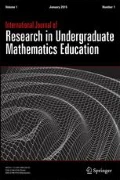Abstract
This study compares the relative influence of syntax, semantics, and pragmatics in university students’ interpretation of multiply quantified statements in mathematics, both before and after instruction. Like previous studies, results show that semantics plays a heavy role in student interpretation, especially before instruction. Unlike previous studies, our data suggests that the patterns of student interpretation rely more upon the mathematical context than upon the order of the quantifiers. We operationalize two of Grice’s (1975) pragmatic Maxims to evaluate whether they help explain which interpretations are harder for students to adopt for various statements. Our data support the claim that students find it easier to construct relevant interpretations, but do not support the claim that students find it easier to construct interpretations that render the statement true. Finally, based on our sample from six Transition to Proof classes across the US, we observe that after their experiences in such courses students became more sensitive to syntax in their interpretation of the statements.







Similar content being viewed by others
Change history
14 September 2019
The original version of this article unfortunately contained two instances where the task names are mislabeled by switching the abbreviations “EA” and “AE.” Under “Rates of Normative Construal” in the “Results” section, second paragraph, fourth sentence, the sentence should be written.
Notes
We use the term “normative construal” to describe the way mathematicians interpret statements of a given form. We use the term “normative” to convey that the understandings we intend for students to develop are those generally agreed upon within the mathematical community.
We acknowledge that the example of inverses (and our diagram thereof) could be overgeneralized in the sense that “each to some” relationships need not include every element in the second in a pair and multiple elements of the first set may be paired to the same element. Also, the pairing may be fixed for each member of the first set (functional) or more flexible (Durand-Guerrier and Arsac 2005).
References
Blau, H. (2008). Foundations of plane geometry. Island Park: Whittier Publications.
Cook, J. P., Dawkins, P. C., & Zazkis, D. (2019). How do transition to proof textbooks relate logic, proof techniques, and sets? In A. Weinberg, D. Moore-Russo, H. Soto, & M. Wawro (Eds.), Proceedings of the 22ndannual conference on research in undergraduate mathematics education (pp. 146–153). Oklahoma City, Oklahoma.
Copi, I. (1954). Symbolic logic. New York: The Macmillan Company.
David, E. J., & Zazkis, D. (2019). Characterizing introduction to proof courses: A survey of US R1 and R2 course syllabi. International Journal of Mathematical Education in Science and Technology, 1–17.
David, E., Roh, K.H., & Sellars, M. (2019). Teaching the representations of concepts in Calculus: The case of the intermediate value theorem. PRIMUS. https://doi.org/10.1080/10511970.2018.1540023.
Dawkins, P. C. (2019). Students’ pronominal sense of reference in mathematics. For the Learning of Mathematics, 39(1), 18–23.
Dawkins, P. C., & Cook, J. P. (2017). Guiding reinvention of conventional tools of mathematical logic: Students’ reasoning about mathematical disjunctions. Educational Studies in Mathematics, 94(3), 241–256.
Dawkins, P., & Roh, K. (2016). Promoting meta-linguistic and meta-mathematical reasoning in proof-oriented mathematics courses: A method and a framework. International Journal of Research in Undergraduate Mathematics Education, 2, 197–222.
Dubinsky, E., & Yiparaki, O. (2000). On student understanding of AE and EA quantification. Research in Collegiate Mathematics Education, IV, 239–289.
Dubinsky, E., Elterman, F., & Gong, C. (1988). The student's construction of quantification. For the Learning of Mathematics, 8(2), 44–51.
Durand-Guerrier, V. (2003). Which notion of implication is the right one? From logical considerations to a didactic perspective. Educational Studies in Mathematics, 53(1), 5–34.
Durand-Guerrier, V., & Arsac, G. (2005). An epistemological and didactic study of a specific calculus reasoning rule. Educational Studies in Mathematics, 60(2), 149–172.
Durand-Guerrier, V., Boero, P., Douek, N., Epp, S. S., & Tanguay, D. (2012). Examining the role of logic in teaching proof. In G. Hanna & M. De Villiers (Eds.), Proof and proving in mathematics education (pp. 369–389). Netherlands: Springer.
Epp, S. (2003). The role of logic in teaching proof. The American Mathematical Monthly, 110, 886–899.
Fletcher, C. R., Lucas, S., & Baron, C. M. (1999) Comprehension of mathematical proofs). In S. R. Goldman, A. C. Graesser, & P. van den Broek (Eds.), Narrative comprehension, causality, and coherence: Essays in honor of tom Trobasso (pp. 195–207). Mahwah: Lawrence Erlbaum Associates.
Glivická, J. (2018). Game semantics in teaching of classical first order predicate logic to students of computer science. In MATEC web of conferences (Vol. 210, p. 4007). EDP Sciences.
Grice, H. P. (1975). Logic and conversation. In P. Cole & J. Morgan (Eds.), Syntax and semantics: Speech acts (Vol. 3, pp. 41–58). London: Academic.
Pinto, M., & Tall, D. (2002). Building formal mathematics on visual imagery: A case study and a theory. For the Learning of Mathematics, 22(1), 2–10.
Roh, K., & Lee, Y. (2011). The Mayan activity: a way of teaching multiple quantifications in logical contexts. PRIMUS, 21, 1–14.
Stenning, K., & van Lambalgen, M. (2004). A little logic goes a long way: Basing experiment on semantic theory in the cognitive science of conditional reasoning. Cognitive Science, 28, 481–529.
Stenning, K., & van Lambalgen, M. (2008). Human reasoning and cognitive science. Cambridge: The MIT Press.
Swinyard, C. (2011). Reinventing the formal definition of limit: The case of Amy and Mike. The Journal of Mathematical Behavior, 30(2), 93–114.
Weber, K., & Alcock, L. (2005). Using warranted implications to understand and validate proofs. For the Learning of Mathematics, 25(1), 34–38.
Author information
Authors and Affiliations
Corresponding author
Ethics declarations
Conflict of Interest
On behalf of all authors, the corresponding author states that there is no conflict of interest.
Additional information
Publisher’s Note
Springer Nature remains neutral with regard to jurisdictional claims in published maps and institutional affiliations.
Rights and permissions
About this article
Cite this article
Dawkins, P.C., Roh, K.H. Assessing the Influence of Syntax, Semantics, and Pragmatics in Student Interpretation of Multiply Quantified Statements in Mathematics. Int. J. Res. Undergrad. Math. Ed. 6, 1–22 (2020). https://doi.org/10.1007/s40753-019-00097-2
Published:
Issue Date:
DOI: https://doi.org/10.1007/s40753-019-00097-2




